The Design and Development of Recycled Concretes in a Circular Economy Using Mixed Construction and Demolition Waste
Abstract
:1. Introduction
2. Materials and Methods
2.1. Materials
2.2. Concrete Properties Studied
2.3. Mix Design
3. Results and Discussion
3.1. Properties in a Fresh State
3.1.1. Consistency
3.1.2. Entrained Air
3.1.3. Density
3.2. Properties in a Hardened State
3.2.1. Density
3.2.2. Compressive Strength
3.2.3. Splitting Tensile Strength
3.2.4. Flexural Resistance
3.2.5. Water Penetration Depth under Pressure
3.2.6. Analysing the Concrete Manufacturing Costs
4. Conclusions
- -
- Coarse (cMRA) and fine (fMRA) mixed recycled aggregate meet the physical and mechanical requirements included in the relevant regulation on aggregates for manufacturing concretes.
- -
- The workability of recycled concretes (M2–M9) is not impacted by the addition of mixed recycled aggregate, regardless of its replacement percentage, with all mixes showing an S2 consistency (50–90 mm).
- -
- The addition of mixed recycled aggregate (cMRA and/or fMRA) causes a linear increase in the entrained air content in a fresh state of 1.9, 2.8 and 2.8 times the M1 mix in mixes M3 (50% fMRA), M6 (25% cMRA + 50% fMRA) and M9 (50% cMRA + 50% fMRA), respectively.
- -
- The density of recycled concretes is lower than that of conventional concrete, with the loss of density increasing as the recycled aggregate replacement percentage rises and with greater intensity when using mixed aggregate. This behaviour is similar both in a fresh and hardened state.
- -
- The compressive strength of recycled concretes is lower than that of conventional concrete, with M9 (50% cMRA + 50% fMRA) having the greatest drop (~11%) compared with M1 after 28 days of curing. After 90 days, recycled concretes have a better behaviour than conventional concretes. The addition of fMRA has a positive effect, establishing that the optimal replacement percentage is 25% in weight, regardless of the percentage of cMRA.
- -
- The compressive strength of all concretes is higher than the design strength (fck = 25 MPa).
- -
- The indirect tensile strength experiences a slight increase with the addition of fMRA, with the maximum increase (~9%) compared with M1 corresponding to the concrete that incorporates 25% of fMRA (M2). The addition of cMRA causes a slight loss (~7%) compared with conventional concrete (M1). This loss is softened with the simultaneous addition of fMRA, obtaining a −0.3% decrease compared with M1 for mix M9 (50% cMRA + 50% fMRA).
- -
- The flexural strength of the new concretes is greater than conventional concrete, with the highest increases (6.3–12.0% compared with M1) belonging to mixes M2, M5 and M9. The addition of 50% of cMRA (M7) causes a −3.4% decrease compared with M1.
- -
- All the concretes designed have a watertight structure under pressure, meeting the maximum and mean depth requirements of the relevant regulation.
- -
- The (maximum and mean) water penetration under pressure decreases slightly for mixes M2, M3, M4 and M5, whereas an increase was registered in one (M6, M7 and M8) or both depths (M9) for all remaining concretes.
- -
- The optimal individual or simultaneous replacement percentage of fMRA and cMRA is 25% in weight, in light of the results obtained in this research study.
- -
- These results reveal the need for future research that addresses the behaviour of these concretes from the viewpoint of their durability properties, as well as investigating different types of mixed recycled aggregates with which to manufacture concretes.
- -
- Lastly, this research will positively contribute to the addition of these mixed recycled aggregates to the concrete-related stipulations of structural codes.
Author Contributions
Funding
Institutional Review Board Statement
Informed Consent Statement
Data Availability Statement
Conflicts of Interest
References
- Comision Europea (EU). No 601/2012 of 21 June 2012 on the Monitoring and Reporting of Greenhouse Gas Emissions Pursuant to Directive 2003/87/EC of the European Parliament and of the Council; European Committee: Brussels, Belgium, 2012. [Google Scholar]
- ERMCO. Ready–Mixed Concrete Industry Statistics. 2018. [Online]. Available online: http://ermco.eu/new/wp-content/uploads/2020/08/ERMCO-Statistics-30.08.2019-R4-1.pdf (accessed on 19 March 2020).
- Monteiro, P.J.M.; Miller, S.; Horvath, A. Towards sustainable concrete. Nat. Mater. 2017, 16, 698–699. [Google Scholar] [CrossRef]
- European Aggregates Association. Annual Review 2019–2020. European Aggregates Association. A Sustainable Industry for a Sustainable Europe. [Online]. Available online: https://uepg.eu/mediatheque/media/UEPG-AR20192020_V13_(03082020)_spreads.pdf (accessed on 5 May 2021).
- Tang, Y.; Feng, W.; Feng, W.; Chen, J.; Bao, D.; Li, L. Compressive properties of rubber-modified recycled aggregate concrete subjected to elevated temperatures. Constr. Build. Mater. 2020, 268, 121181. [Google Scholar] [CrossRef]
- Rahla, K.M.; Mateus, R.; Bragança, L. Comparative sustainability assessment of binary blended concretes using Supplementary Cementitious Materials (SCMs) and Ordinary Portland Cement (OPC). J. Clean. Prod. 2019, 220, 445–459. [Google Scholar] [CrossRef]
- Ray, S.; Haque, M.; Sakib, N.; Mita, A.F.; Rahman, M.M.; Tanmoy, B.B. Use of ceramic wastes as aggregates in concrete production: A review. J. Build. Eng. 2021, 43, 102567. [Google Scholar] [CrossRef]
- Aghayan, I.; Khafajeh, R.; Shamsaei, M. Life cycle assessment, mechanical properties, and durability of roller compacted concrete pavement containing recycled waste materials. Int. J. Pavement Res. Technol. 2020, 14, 595–606. [Google Scholar] [CrossRef]
- Horňáková, M.; Lehner, P. Relationship of Surface and Bulk Resistivity in the Case of Mechanically Damaged Fibre Reinforced Red Ceramic Waste Aggregate Concrete. Materials 2020, 13, 5501. [Google Scholar] [CrossRef] [PubMed]
- Bravo, M.; de Brito, J.; Pontes, J.; Evangelista, L. Mechanical performance of concrete made with aggregates from construction and demolition waste recycling plants. J. Clean. Prod. 2015, 99, 59–74. [Google Scholar] [CrossRef]
- Thomas, C.; Setién, J.; Polanco, J.A.; Alaejos, P.; De Juan, M.S. Durability of recycled aggregate concrete. Constr. Build. Mater. 2013, 40, 1054–1065. [Google Scholar] [CrossRef]
- Etxeberria, M.; Vázquez, E.; Mari, A.; Barra, M. Influence of amount of recycled coarse aggregates and production process on properties of recycled aggregate concrete. Cem. Concr. Res. 2007, 37, 735–742. [Google Scholar] [CrossRef]
- McNeil, K.; Kang, T.H.-K. Recycled Concrete Aggregates: A Review. Int. J. Concr. Struct. Mater. 2013, 7, 61–69. [Google Scholar] [CrossRef] [Green Version]
- Evangelista, L.; de Brito, J. Durability performance of concrete made with fine recycled concrete aggregates. Cem. Concr. Compos. 2010, 32, 9–14. [Google Scholar] [CrossRef]
- Ju, M.; Park, K.; Park, W.-J. Mechanical Behavior of Recycled Fine Aggregate Concrete with High Slump Property in Normal- and High-Strength. Int. J. Concr. Struct. Mater. 2019, 13, 61. [Google Scholar] [CrossRef]
- Bravo, M.; Duarte, A.P.C.; De Brito, J.; Evangelista, L.; Pedro, D. On the Development of a Technical Specification for the Use of Fine Recycled Aggregates from Construction and Demolition Waste in Concrete Production. Materials 2020, 13, 4228. [Google Scholar] [CrossRef]
- Fernández, S.V. Physical-mechanical characterization of the structural concrete made with recycled aggregates: Experimental comparative with substitution of fine and coarse aggregates. An. Edif. 2017, 3, 24–31. [Google Scholar]
- Plaza, P.; del Bosque, I.S.; Frías, M.; de Rojas, M.S.; Medina, C. Use of recycled coarse and fine aggregates in structural eco-concretes. Physical and mechanical properties and CO2 emissions. Constr. Build. Mater. 2021, 285, 122926. [Google Scholar] [CrossRef]
- Corinaldesi, V. Mechanical and elastic behaviour of concretes made of recycled-concrete coarse aggregates. Constr. Build. Mater. 2010, 24, 1616–1620. [Google Scholar] [CrossRef]
- Malešev, M.; Radonjanin, V.; Marinković, S. Recycled Concrete as Aggregate for Structural Concrete Production. Sustainability 2010, 2, 1204–1225. [Google Scholar] [CrossRef] [Green Version]
- López-Gayarre, F.; Serna, P.; Domingo-Cabo, A.; Serrano-López, M.; López-Colina, C. Influence of recycled aggregate quality and proportioning criteria on recycled concrete properties. Waste Manag. 2009, 29, 3022–3028. [Google Scholar] [CrossRef]
- Lovato, P.S.; Possan, E.; Molin, D.C.C.D.; Masuero, B.; Ribeiro, J.L. Modeling of mechanical properties and durability of recycled aggregate concretes. Constr. Build. Mater. 2012, 26, 437–447. [Google Scholar] [CrossRef]
- Agrela, F.; de Juan, M.S.; Ayuso, J.; Geraldes, V.; Jiménez, J.R. Limiting properties in the characterisation of mixed recycled aggregates for use in the manufacture of concrete. Constr. Build. Mater. 2011, 25, 3950–3955. [Google Scholar] [CrossRef] [Green Version]
- del Bosque, I.S.; Zhu, W.; Howind, T.; Matías, A.; de Rojas, M.S.; Medina, C. Properties of interfacial transition zones (ITZs) in concrete containing recycled mixed aggregate. Cem. Concr. Compos. 2017, 81, 25–34. [Google Scholar] [CrossRef] [Green Version]
- Martínez-Lage, I.; Vázquez-Burgo, P.; Velay-Lizancos, M. Sustainability evaluation of concretes with mixed recycled aggregate based on holistic approach: Technical, economic and environmental analysis. Waste Manag. 2020, 104, 9–19. [Google Scholar] [CrossRef] [PubMed]
- Martínez-Lage, I.; Martínez-Abella, F.; Vázquez-Herrero, C.; Ordóñez, J.L.P. Properties of plain concrete made with mixed recycled coarse aggregate. Constr. Build. Mater. 2012, 37, 171–176. [Google Scholar] [CrossRef]
- Mas, B.; Cladera, A.; Bestard, J.; Muntaner, D.; López, C.E.; Piña, S.; Prades, J. Concrete with mixed recycled aggregates: Influence of the type of cement. Constr. Build. Mater. 2012, 34, 430–441. [Google Scholar] [CrossRef]
- López-Uceda, A.; Ayuso, J.; Lopez, M.; Jiménez, J.R.; Agrela, F.; Sierra, M.J. Properties of Non-Structural Concrete Made with Mixed Recycled Aggregates and Low Cement Content. Materials 2016, 9, 74. [Google Scholar] [CrossRef] [Green Version]
- Medina, C.; Zhu, W.; Howind, T.; De Rojas, M.I.S.; Frías, M. Influence of mixed recycled aggregate on the physical–mechanical properties of recycled concrete. J. Clean. Prod. 2014, 68, 216–225. [Google Scholar] [CrossRef]
- Cantero, B.; del Bosque, I.S.; Matías, A.; Medina, C. Statistically significant effects of mixed recycled aggregate on the physical-mechanical properties of structural concretes. Constr. Build. Mater. 2018, 185, 93–101. [Google Scholar] [CrossRef]
- Díaz, M.; Almendro-Candel, M.B.; Blanco, D.; Jordan, M.M. Aggregate Recycling in Construction: Analysis of the Gaps between the Chilean and Spanish Realities. Buildings 2019, 9, 154. [Google Scholar] [CrossRef] [Green Version]
- European Committee for Standardization. EN 12620. Aggregates for Concrete; European Committee for Standardization: Brussels, Belgium, 2009. [Google Scholar]
- Ministry of Public Works. Code on Structural Concrete (EHE-08); Ministry of Public Works: Madrid, Spain, 2008; p. 704. [Google Scholar]
- European Committee for Standardization. EN 197. Cement. Part 1: Composition, Specifications and Conformity Criteria for Common Cements; European Committee for Standardization: Brussels, Belgium, 2011. [Google Scholar]
- Spanish Committee for Standardization. UNE 83966. Concrete Durability. Test Methods. Conditioning of Concrete Test Pieces for the Purpose of Gas Permeability and Capilar Suction Tests; Spanish Committee for Standardization: Madrid, Spain, 2008. [Google Scholar]
- Teychenné, D.C.; Franklin, R.E. Design of Normal Concrete Mixes; Spanish Committee for Standardization: Madrid, Spain, 2010; p. 42. [Google Scholar]
- European Committee for Standardization. EN 933. Tests for Geometrical Properties of Aggregates–Part 11: Classification Test for the Constituents of Coarse Recycled Aggregate; European Committee for Standardization: Brussels, Belgium, 2010. [Google Scholar]
- European Committee for Standardization. EN 12350-6. Testing Fresh Concrete–Part 6: Density; European Committee for Standardization: Brussels, Belgium, 2020. [Google Scholar]
- European Committee for Standardization. EN 12350-7. Testing Fresh Concrte–Part 7: Air Content–Pressure Methods. 2020. Link: BS EN 12350-7:2019 Testing Fresh Concrete Air Content. Pressure Methods–European Standards (en-standard.eu); European Committee for Standardization: Brussels, Belgium, 2020. [Google Scholar]
- European Committee for Standardization. EN 12350-2. Testing Fresh Concrete–Part 2: Slump Test. 2020. Link: BS EN 12350-2:2019 Testing Fresh Concrete Slump Test–European Standards (en-standard.eu); European Committee for Standardization: Brussels, Belgium, 2020. [Google Scholar]
- European Committee for Standardization. EN 12390-7. Testing Hardened Concrete–Part 7: Density of Hardened Concrete; European Committee for Standardization: Brussels, Belgium, 2020. [Google Scholar]
- European Committee for Standardization. EN 12390-6. Testing Hardened Concrete–Part 6: Tensile Splitting Strength of Test Specimens; European Committee for Standardization: Brussels, Belgium, 2020. [Google Scholar]
- European Committee for Standardization. EN 12390-5. Testing Hardened Concrete–Part 5: Flexural Strength of Test Specimens; European Committee for Standardization: Brussels, Belgium, 2020. [Google Scholar]
- European Committee for Standardization. EN 12390-8. Testing Hardened Concrete–Part 8: Depth of Penetration of Water under Pressure; European Committee for Standardization: Brussels, Belgium, 2020. [Google Scholar]
- European Committee for Standardization. EN-206. Concrete–Specification, Performance, Production and Conformity; European Committee for Standardization: Brussels, Belgium, 2018. [Google Scholar]
- European Committee for Standardization. EN 1239-2. Testing Hardened Concrete–Part 2: Making and Curing Specimens for Strength Tests; European Committee for Standardization: Brussels, Belgium, 2020. [Google Scholar]
- Kurda, R.; de Brito, J.; Silvestre, J.D. Influence of recycled aggregates and high contents of fly ash on concrete fresh properties. Cem. Concr. Compos. 2017, 84, 198–213. [Google Scholar] [CrossRef]
- Masood, B.; Elahi, A.; Barbhuiya, S.; Ali, B. Mechanical and durability performance of recycled aggregate concrete incorporating low calcium bentonite. Constr. Build. Mater. 2019, 237, 117760. [Google Scholar] [CrossRef]
- Yaprak, H.; Aruntas, H.Y.; Demir, I.; Simsek, O.; Durmus, G. Effects of the fine recycled concrete aggregates on the concrete properties. Int. J. Phys. Sci. 2011, 6, 2455–2461. [Google Scholar]
- de Brito, J.; Agrela, F.; Silva, R.V. Construction and demolition waste. In Newtrends in Eco-Efficient and Recycled Concrete; De Brito, J., Agrela, F., Eds.; Woodhead Publishing: Amsterdam, The Netherlads, 2019; Volume 1, pp. 1–22. [Google Scholar]
- Gonzalez-Corominas, A.; Etxeberria, M. Properties of high performance concrete made with recycled fine ceramic and coarse mixed aggregates. Constr. Build. Mater. 2014, 68, 618–626. [Google Scholar] [CrossRef]
- Nepomuceno, M.; Isidoro, R.A.; Catarino, J.P. Mechanical performance evaluation of concrete made with recycled ceramic coarse aggregates from industrial brick waste. Constr. Build. Mater. 2018, 165, 284–294. [Google Scholar] [CrossRef]
- Mehta, P.D.P.K.; Paulo, P.D.; Monteiro, J.M. Proportioning Concrete Mixtures. In Concrete: Microstructure, Properties, and Materials, 4th ed.; McGraw Hill Professional: Toronto, ON, Canada, 2014. [Google Scholar]
- Poon, C.; Shui, Z.; Lam, L.; Fok, H.; Kou, S. Influence of moisture states of natural and recycled aggregates on the slump and compressive strength of concrete. Cem. Concr. Res. 2004, 34, 31–36. [Google Scholar] [CrossRef]
- Gomes, M.; De Brito, J.; Bravo, M. Mechanical Performance of Structural Concrete with the Incorporation of Coarse Recycled Concrete and Ceramic Aggregates. J. Mater. Civ. Eng. 2014, 26, 04014076. [Google Scholar] [CrossRef]
- Lotfy, A.; Al-Fayez, M. Performance evaluation of structural concrete using controlled quality coarse and fine recycled concrete aggregate. Cem. Concr. Compos. 2015, 61, 36–43. [Google Scholar] [CrossRef]
- Evangelista, L.; de Brito, J. Mechanical behaviour of concrete made with fine recycled concrete aggregates. Cem. Concr. Compos. 2007, 29, 397–401. [Google Scholar] [CrossRef]
- Khatib, J. Properties of concrete incorporating fine recycled aggregate. Cem. Concr. Res. 2005, 35, 763–769. [Google Scholar] [CrossRef]
- Nedeljković, M.; Visser, J.; Šavija, B.; Valcke, S.; Schlangen, E. Use of fine recycled concrete aggregates in concrete: A critical review. J. Build. Eng. 2021, 38, 102196. [Google Scholar] [CrossRef]
- Medina, C.; Banfill, P.; de Rojas, M.I.S.; Frías, M. Rheological and calorimetric behaviour of cements blended with containing ceramic sanitary ware and construction/demolition waste. Constr. Build. Mater. 2012, 40, 822–831. [Google Scholar] [CrossRef]
- Medina, C.; Del Bosque, I.F.S.; Asensio, E.; Frías, M.; De Rojas, M.I.S.; De Rojas, M.I.S. New additions for eco-efficient cement design. Impact on calorimetric behaviour and comparison of test methods. Mater. Struct. 2016, 49, 4595–4607. [Google Scholar] [CrossRef] [Green Version]
- Asensio, E.; Medina, C.; Frías, M.; De Rojas, M.I.S. Characterization of Ceramic-Based Construction and Demolition Waste: Use as Pozzolan in Cements. J. Am. Ceram. Soc. 2016, 99, 4121–4127. [Google Scholar] [CrossRef]
- Asensio, E.; Medina, C.; Frías, M.; De Rojas, M.I.S. Use of clay-based construction and demolition waste as additions in the design of new low and very low heat of hydration cements. Mater. Struct. 2018, 51, 101. [Google Scholar] [CrossRef]
- Rao, M.C. Influence of brick dust, stone dust, and recycled fine aggregate on properties of natural and recycled aggregate concrete. Struct. Concr. 2020, 22, E105–E120. [Google Scholar] [CrossRef]
- European Committe for Standardization. EN 12390-3:2009. Testing Hardened Concrete. Part 3: Compressive Strengh of Test Specimens; European Committee for Standardization: Brussels, Belgium, 2009. [Google Scholar]
- Medina, C.; Sánchez, J.; Del Bosque, I.S.; Frías, M.; De Rojas, M.S. Meso-structural modelling in recycled aggregate concrete. In New Trends in Eco-Efficient and Recycled Concrete; Woodhead Publishing: Amsterdam, The Netherlands, 2019; pp. 453–476. [Google Scholar] [CrossRef]
- Medina, C.; Sánchez, J.; del Bosque, I.S.; Frías, M.; de Rojas, M.S. Modeling the interfacial transition zone between recycled aggregates and industrial waste in cementitious matrix. In Waste and Byproducts in Cement-Based Materials; Woodhead Publishing: Amsterdam, The Netherlands, 2021; pp. 3–27. [Google Scholar] [CrossRef]
- Ahmed, S. Properties of Concrete Containing Recycled Fine Aggregate and Fly Ash. J. Solid Waste Technol. Manag. 2014, 40, 70–78. [Google Scholar] [CrossRef] [Green Version]
- Kirthika, S.K.; Singh, S.K.; Chourasia, A. Performance of Recycled Fine-Aggregate Concrete Using Novel Mix-Proportioning Method. J. Mater. Civ. Eng. 2020, 32, 04020216. [Google Scholar] [CrossRef]
- Kou, S.-C.; Poon, C.S.; Wan, H.-W. Properties of concrete prepared with low-grade recycled aggregates. Constr. Build. Mater. 2012, 36, 881–889. [Google Scholar] [CrossRef]
- Yang, J.; Du, Q.; Bao, Y. Concrete with recycled concrete aggregate and crushed clay bricks. Constr. Build. Mater. 2011, 25, 1935–1945. [Google Scholar] [CrossRef]
- Kou, S.C.; Poon, C.S.; Chan, D. Influence of Fly Ash as Cement Replacement on the Properties of Recycled Aggregate Concrete. J. Mater. Civ. Eng. 2007, 19, 709–717. [Google Scholar] [CrossRef]
- Elhakam, A.A.; Mohamed, A.E.; Awad, E. Influence of self-healing, mixing method and adding silica fume on mechanical properties of recycled aggregates concrete. Constr. Build. Mater. 2012, 35, 421–427. [Google Scholar] [CrossRef]
- Wang, Y.; Zhang, H.; Geng, Y.; Wang, Q.; Zhang, S. Prediction of the elastic modulus and the splitting tensile strength of concrete incorporating both fine and coarse recycled aggregate. Constr. Build. Mater. 2019, 215, 332–346. [Google Scholar] [CrossRef]
- Kumar, R.; Gurram, S.C.B.; Minocha, A.K. Influence of recycled fine aggregate on microstructure and hardened properties of concrete. Mag. Concr. Res. 2017, 69, 1288–1295. [Google Scholar] [CrossRef]
- Bordy, A.; Younsi, A.; Aggoun, S.; Fiorio, B. Cement substitution by a recycled cement paste fine: Role of the residual anhydrous clinker. Constr. Build. Mater. 2017, 132, 1–8. [Google Scholar] [CrossRef]
- Mas, B.; Cladera, A.; del Olmo, T.; Pitarch, F. Influence of the amount of mixed recycled aggregates on the properties of concrete for non-structural use. Constr. Build. Mater. 2012, 27, 612–622. [Google Scholar] [CrossRef]
- Velardo, P.; del Bosque, I.S.; Matías, A.; de Rojas, M.S.; Medina, C. Properties of concretes bearing mixed recycled aggregate with polymer-modified surfaces. J. Build. Eng. 2021, 38, 102211. [Google Scholar] [CrossRef]

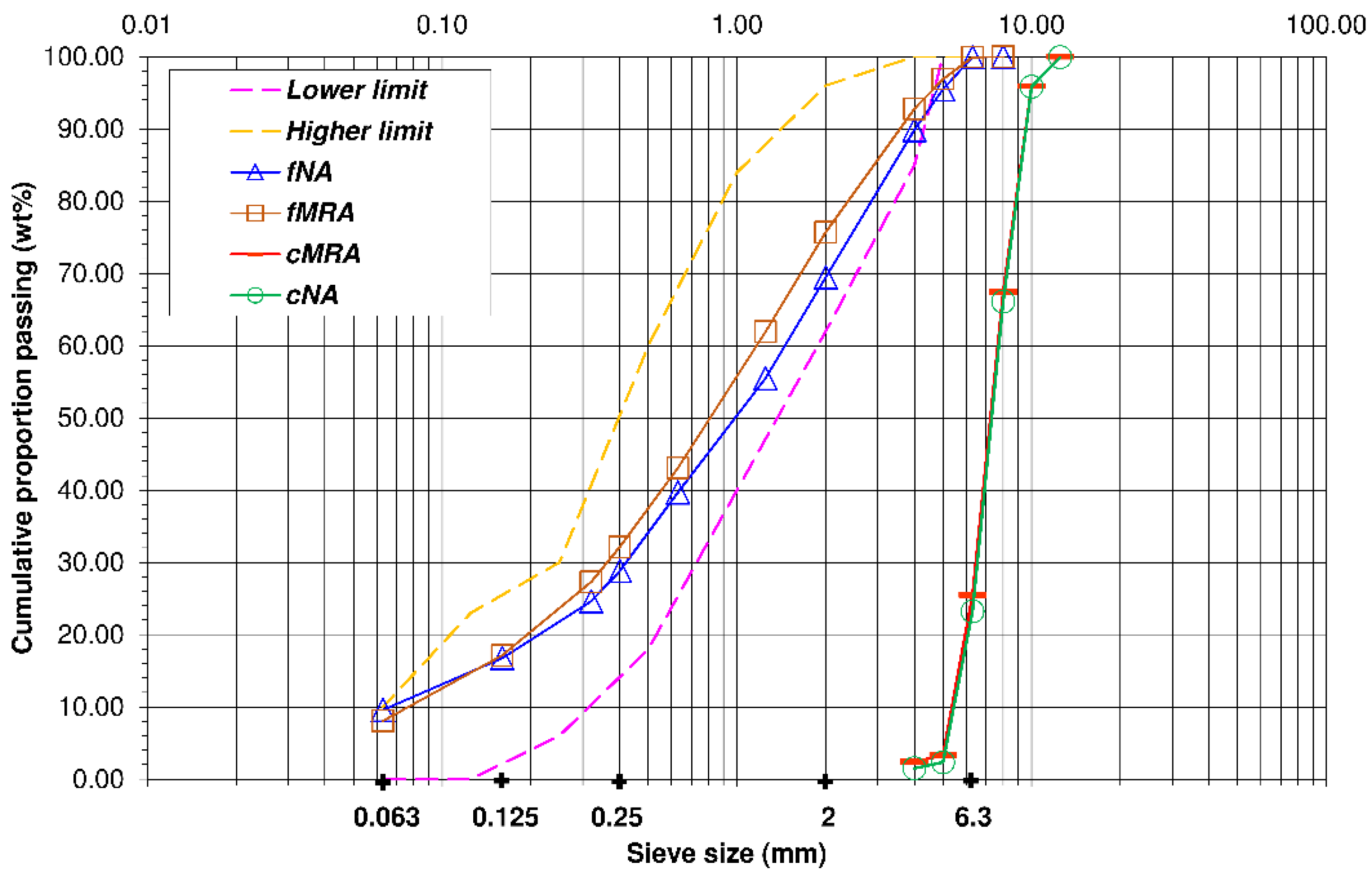
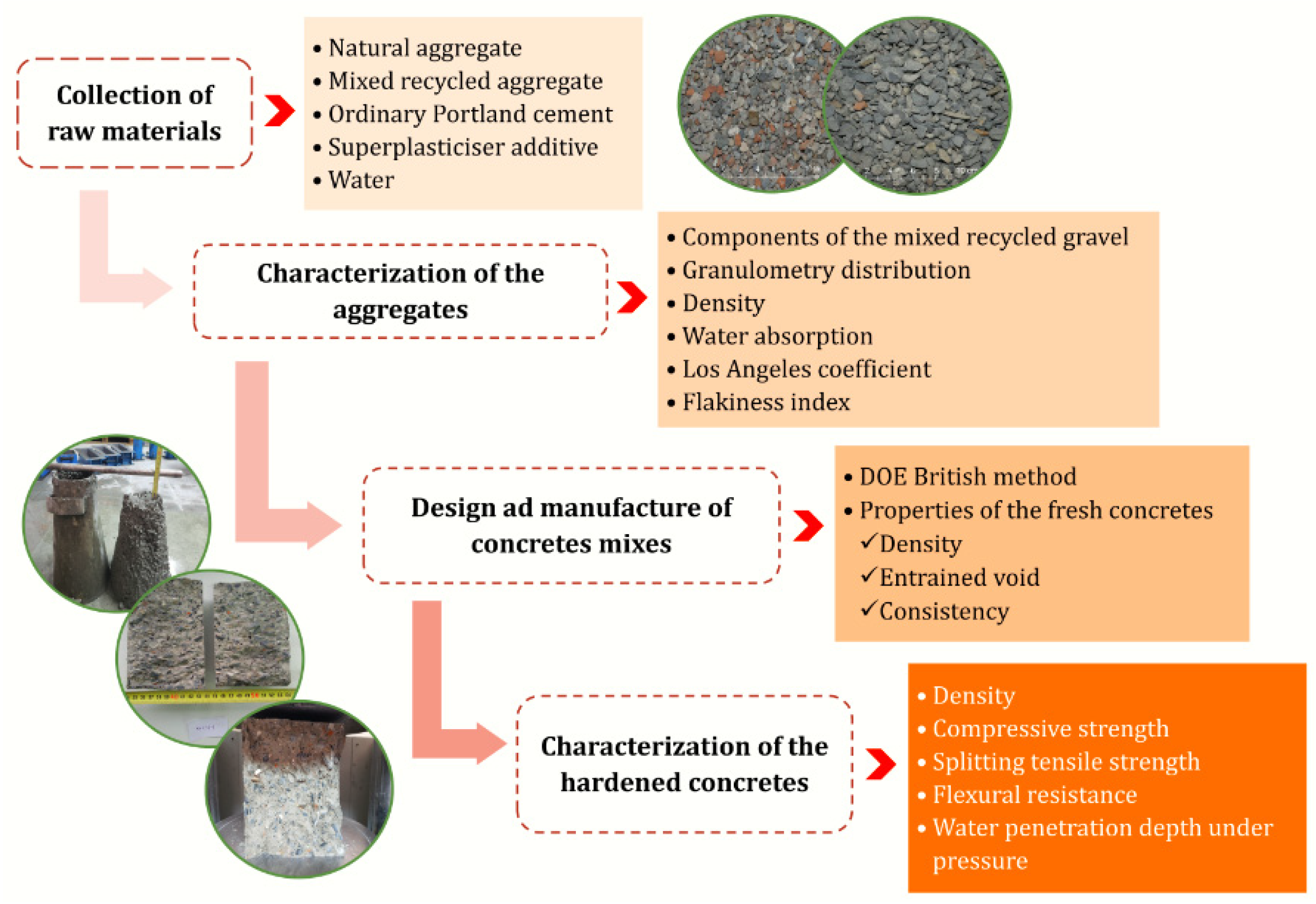
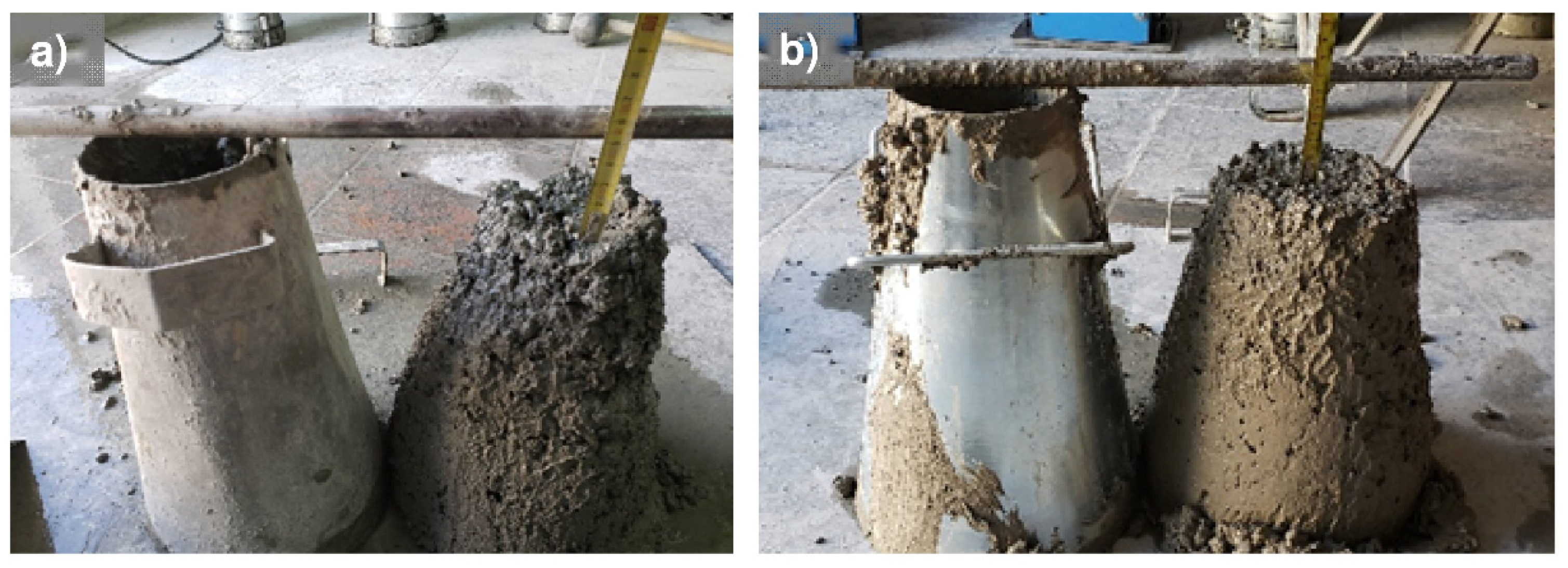

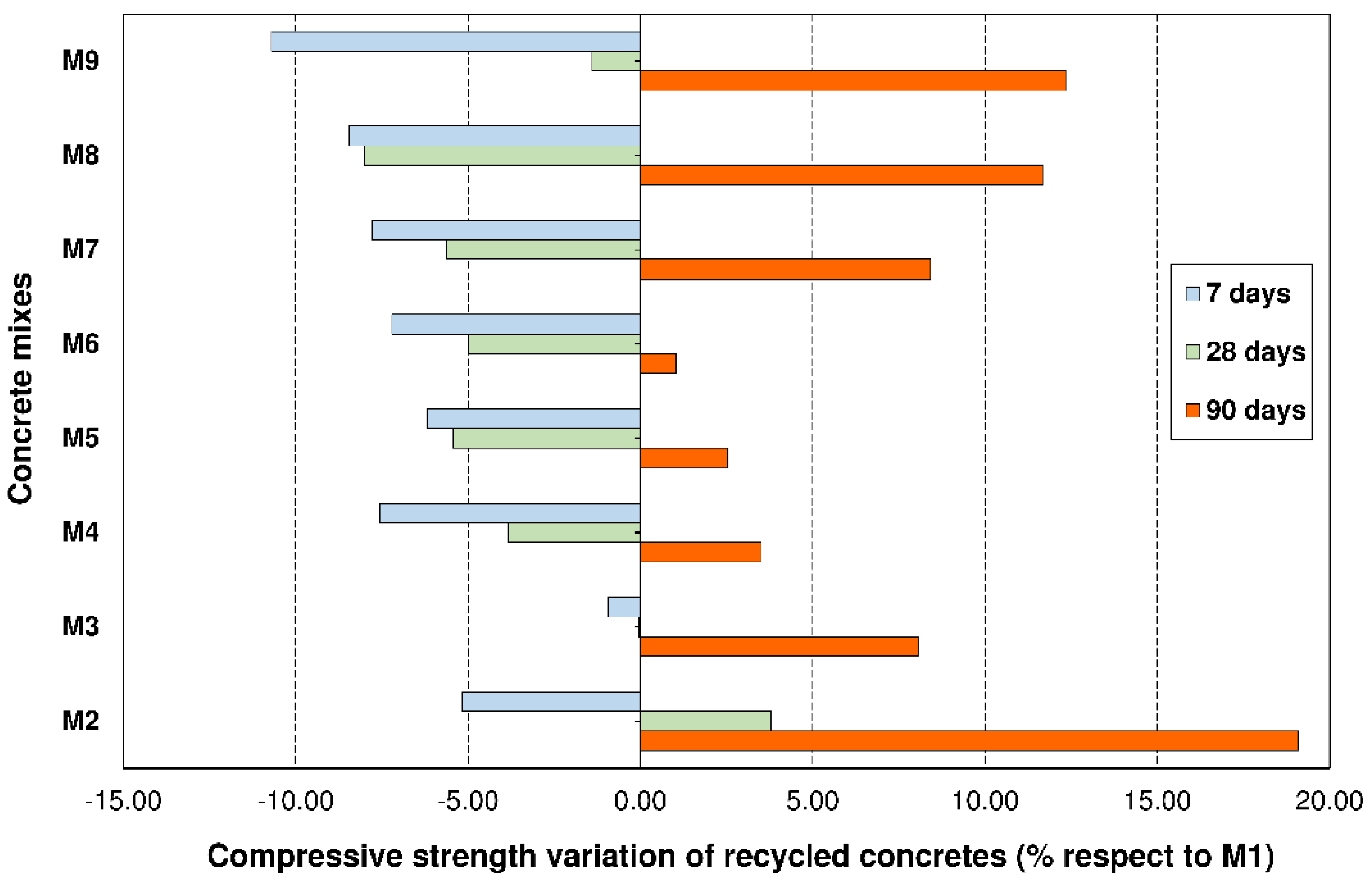
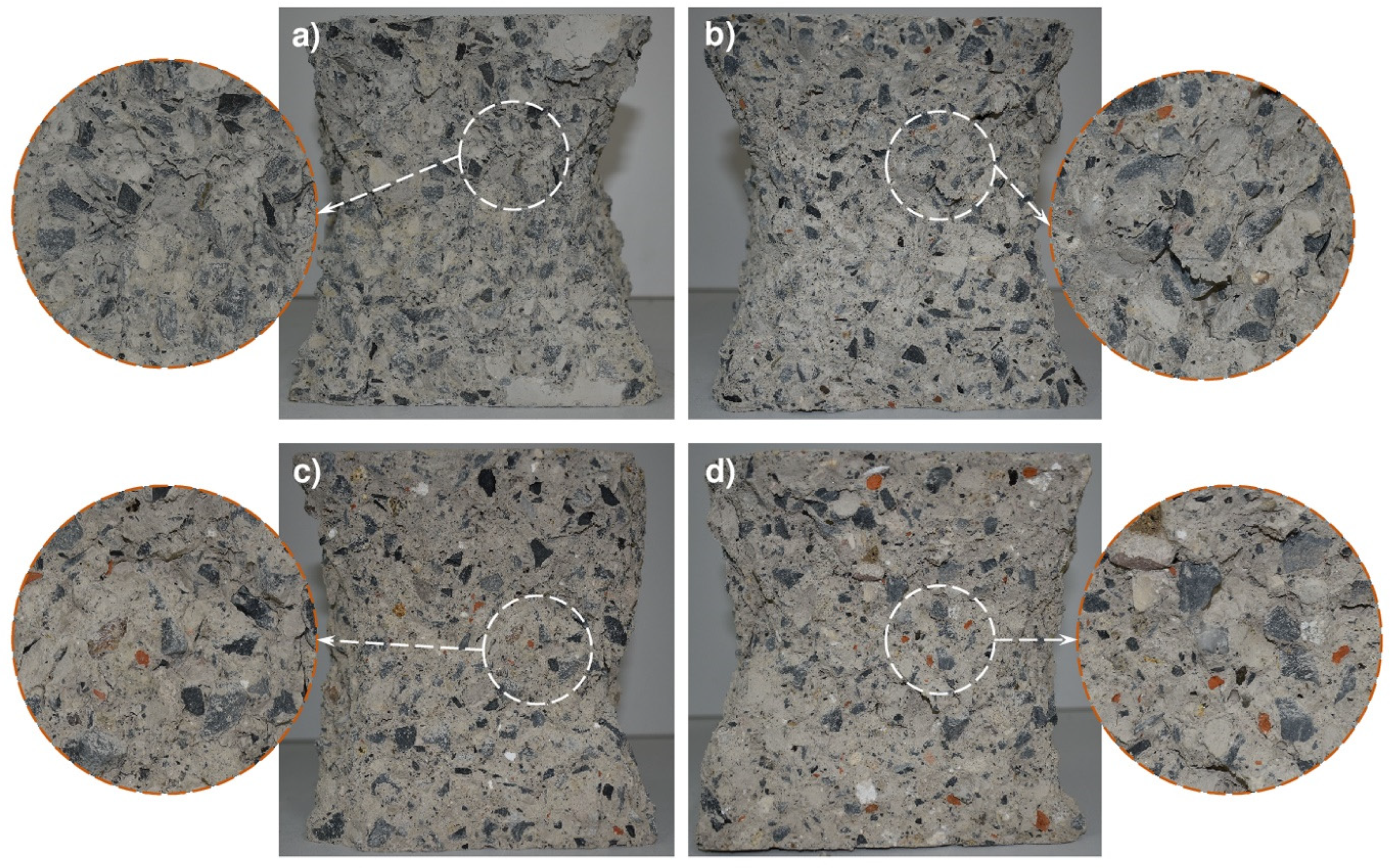


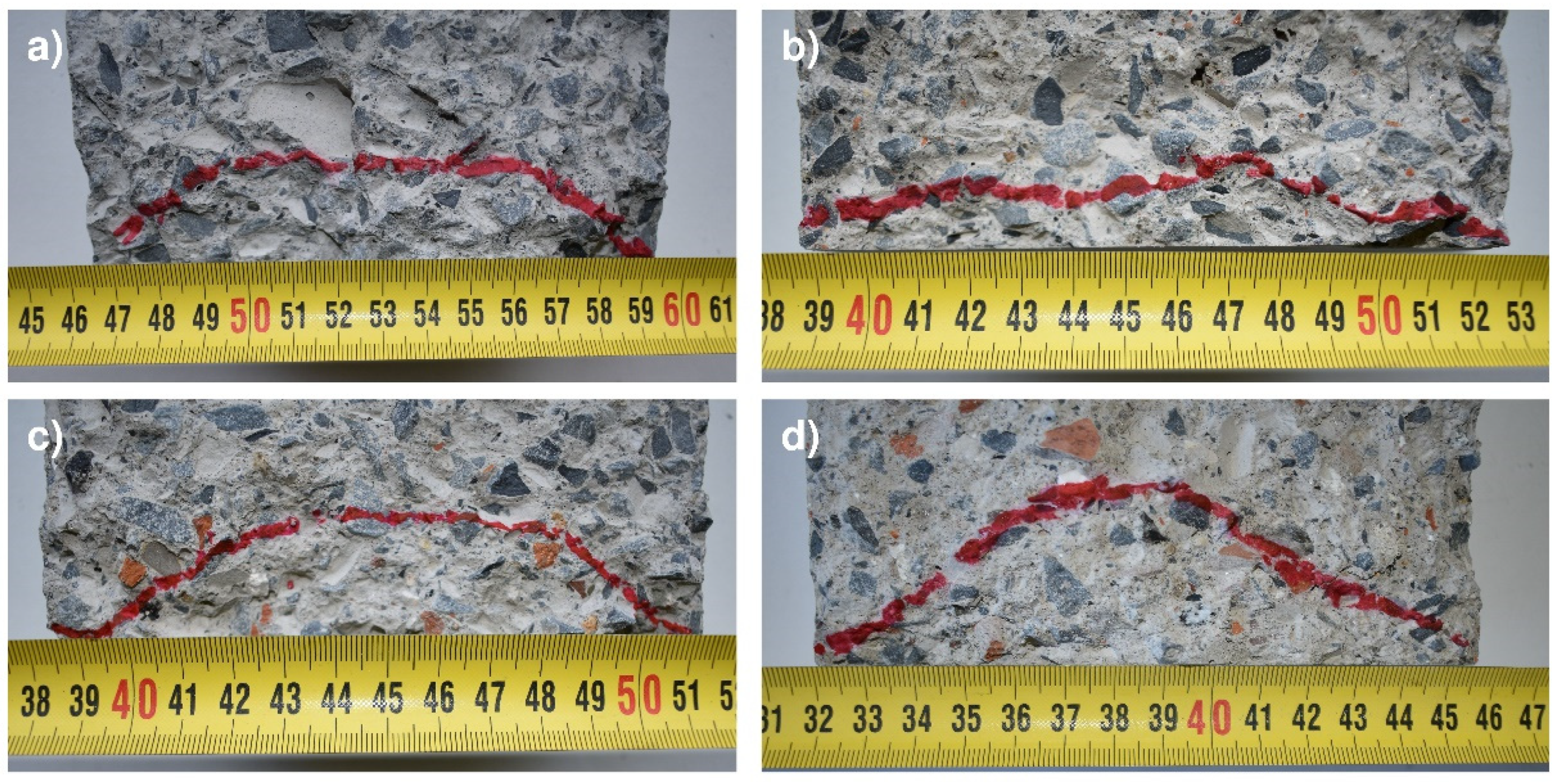
| Continent | Material | Fraction | % Allowed | Type of Concrete | |
|---|---|---|---|---|---|
| Minimum Value | Maximum Value | ||||
| Asia (China, Korea and Japan) | RCA | Coarse | 20 | 100 | Structural |
| Fine | 30 | 100 | Structural | ||
| Coarse Fine | 0 0 | 100 30 | Non-structura Non-structural | ||
| Australia | RCA | Coarse | - | 30 | Structural |
| MRA | Coarse | - | 100 | Structural | |
| Europe (Belgium, Germany, Italy, Denmark, Holland, Portugal, Switzerland, United Kingdom, France, Spain) | RCA | Coarse | 15 | 100 | Structural |
| Coarse/Fine | - | 100 | Structural | ||
| MRA | Coarse | 25 | 100 | Structural | |
| Fine | - | 20 | Non-structural | ||
| America (Brazil) | RCA | Coarse/Fine | - | 100 | Non-structural |
| MRA | Coarse/Fine | - | 100 | Non-structural | |
| Property | Aggregates | EN-12620/ EHE08 | |||
|---|---|---|---|---|---|
| fNA | cNA | fMRA | cMRA | ||
| Dssd (kg/m3) [34] | 2.76 | 2.74 | 2.70 | 2.42 | - |
| WA24 (wt %) [34] | 1.18 | 0.88 | 5.39 | 6.28 | <5 |
| LC (wt %) [35] | - | 16 | - | 32 | <40 |
| FI (wt %) [36] | - | 21 | 10 | <35 | |
| Class | Type | Content (% Weight) |
|---|---|---|
| Rc | Concrete and mortar | 43.98 |
| Ru | Natural stone | 43.94 |
| Rc + Ru | 87.82 | |
| Rb | Baked clay material | 10.93 |
| Ra | Asphalt | 0.87 |
| FL | Floating particles | 0.02 |
| G | Gypsum | 0.34 |
| X + Rg | Others and glass | 0.02 |
| Properties | Trial | Standard | Sample Size (mm) | Trial Duration (days) |
|---|---|---|---|---|
| Physical | Density | EN 12350-6 [39] | Cubic 150 × 150 × 150 | Beginning |
| Entrained air | EN 12350-7 [40] | - | Beginning | |
| Consistency | EN 12350-2 [41] | - | Beginning | |
| Mechanical | Compression | EN 12390-7 [42] | Cubic 150 × 150 × 150 | 7, 28 and 90 |
| Traction | EN 12390-6 [43] | Cylindrical 100 ϕ × 200 | 28 | |
| Bending | EN 12390-5 [44] | Prismatic 100 × 100 × 400 | 28 | |
| Durable | Penetration under pressure | EN 12390-8 [45] | Cylindrical 150 ϕ × 300 | 28 |
| Materials (kg/m3) | Mix | ||||||||
|---|---|---|---|---|---|---|---|---|---|
| M1 | M2 | M3 | M4 | M5 | M6 | M7 | M8 | M9 | |
| fNA | 916.8 | 684.0 | 446.4 | 902.4 | 666.0 | 434.4 | 888.0 | 648.0 | 429.6 |
| fMRA | 0.0 | 228.0 | 446.4 | 0.0 | 222.0 | 434.4 | 0.0 | 216.0 | 429.6 |
| cNA | 993.2 | 988.0 | 967.2 | 733.2 | 721.50 | 705.90 | 481.0 | 468.0 | 465.4 |
| cMRA | 0.0 | 0.0 | 0.0 | 244.4 | 240.5 | 235.3 | 481.0 | 468.0 | 465.4 |
| Cement | 380.0 | 380.0 | 380.0 | 380.0 | 380.0 | 380.0 | 380.0 | 380.0 | 380.0 |
| Water | 224.4 | 228.9 | 231.1 | 232.8 | 237.4 | 241.5 | 243.9 | 247.5 | 252.3 |
| Additive | 5.9 | 5.9 | 5.9 | 5.9 | 5.9 | 5.9 | 5.9 | 5.9 | 5.9 |
| Mix | Consistency (cm) | Entrained Air (vol %) | Density (kg/m3) |
|---|---|---|---|
| M1 | 6.00 | 1.97 | 2416.37 |
| M2 | 6.00 | 3.00 | 2380.97 |
| M3 | 5.17 | 3.90 | 2354.57 |
| M4 | 5.50 | 2.20 | 2372.79 |
| M5 | 5.50 | 3.60 | 2322.27 |
| M6 | 6.50 | 5.50 | 2275.41 |
| M7 | 6.50 | 2.77 | 2331.01 |
| M8 | 5.67 | 4.20 | 2286.24 |
| M9 | 5.17 | 5.57 | 2288.47 |
| Mix | D28d (kg/m3) | acs7d | σ | acs28d | σ | acs90d | σ |
|---|---|---|---|---|---|---|---|
| M1 | 2412.15 | 33.45 | 0.26 | 40.02 | 0.22 | 46.67 | 0.67 |
| M2 | 2377.78 | 31.72 | 0.38 | 41.54 | 1.10 | 55.58 | 0.75 |
| M3 | 2330.17 | 33.14 | 0.61 | 40.00 | 0.46 | 50.43 | 0.72 |
| M4 | 2368.30 | 30.92 | 0.69 | 38.48 | 0.33 | 48.31 | 0.31 |
| M5 | 2321.38 | 31.38 | 1.04 | 37.84 | 0.34 | 47.85 | 0.23 |
| M6 | 2274.07 | 31.04 | 0.28 | 38.02 | 0.41 | 47.16 | 0.94 |
| M7 | 2319.11 | 30.85 | 0.80 | 37.77 | 0.49 | 50.60 | 0.87 |
| M8 | 2283.52 | 30.62 | 0.90 | 36.82 | 0.91 | 52.12 | 0.72 |
| M9 | 2278.12 | 29.87 | 0.53 | 39.46 | 0.79 | 52.44 | 0.83 |
| Mix | fcmt (MPa) | Δfcmt (%) ♣ | Δfcmt (%) | fcmf (MPa) | Δfcmf (%) ♣ | Δfcmf (%) |
|---|---|---|---|---|---|---|
| M1 | 3.45 ± 0.09 | - | - | 3.82 ± 0.12 | - | - |
| M2 | 3.75 ± 0.07 | +8.70 | - | 4.16 ± 0.11 | +8.90 | - |
| M3 | 3.54 ± 0.13 | +5.51 | - | 4.15 ± 0.23 | +8.64 | - |
| M4 | 3.21 ± 0.05 | −6.96 | - | 4.10 ± 0.02 | +7.33 | - |
| M5 | 3.41 ± 0.06 | −1.16 | +6.23 ♠ | 4.28 ± 0.09 | +12.04 | +4.39 ♠ |
| M6 | 3.31 ± 0.07 | −4.06 | +3.12 ♠ | 4.21 ± 0.06 | +10.21 | +2.68 ♠ |
| M7 | 3.29 ± 0.06 | −4.64 | - | 3.69 ± 0.27 | −3.40 | - |
| M8 | 3.40 ± 0.05 | −1.45 | +3.34 * | 3.83 ± 0.21 | +0.26 | +3.79 * |
| M9 | 3.44 ± 0.06 | −0.29 | +4.56 * | 4.06 ± 0.20 | +6.28 | +10.03 * |
| Component | Unit Price (EUR/t) | Concrete Mix | ||||||||
|---|---|---|---|---|---|---|---|---|---|---|
| M1 | M2 | M3 | M4 | M5 | M6 | M7 | M8 | M9 | ||
| fNA | 6.79 | 6.23 | 4.64 | 3.03 | 6.13 | 4.52 | 2.95 | 6.03 | 4.40 | 2.92 |
| fMRA | 3.60 | 0.00 | 0.82 | 1.61 | 0.00 | 0.80 | 1.56 | 0.00 | 0.78 | 1.55 |
| Can | 6.54 | 6.50 | 6.46 | 6.33 | 4.80 | 4.72 | 4.62 | 3.15 | 3.06 | 3.04 |
| cMRA | 3.15 | 0.00 | 0.00 | 0.00 | 0.77 | 0.76 | 0.74 | 1.52 | 1.47 | 1.47 |
| Cement | 88.60 | 33.67 | 33.67 | 33.67 | 33.67 | 33.67 | 33.67 | 33.67 | 33.67 | 33.67 |
| Water | 0.50 | 0.11 | 0.11 | 0.12 | 0.12 | 0.12 | 0.12 | 0.12 | 0.12 | 0.13 |
| Admixture | 1.56 | 0.01 | 0.01 | 0.01 | 0.01 | 0.01 | 0.01 | 0.01 | 0.01 | 0.01 |
| EUR/m3 concrete | - | 46.51 | 45.72 | 44.76 | 45.49 | 44.59 | 43.67 | 44.49 | 43.51 | 42.78 |
Publisher’s Note: MDPI stays neutral with regard to jurisdictional claims in published maps and institutional affiliations. |
© 2021 by the authors. Licensee MDPI, Basel, Switzerland. This article is an open access article distributed under the terms and conditions of the Creative Commons Attribution (CC BY) license (https://creativecommons.org/licenses/by/4.0/).
Share and Cite
González, M.D.; Plaza Caballero, P.; Fernández, D.B.; Jordán Vidal, M.M.; del Bosque, I.F.S.; Medina Martínez, C. The Design and Development of Recycled Concretes in a Circular Economy Using Mixed Construction and Demolition Waste. Materials 2021, 14, 4762. https://doi.org/10.3390/ma14164762
González MD, Plaza Caballero P, Fernández DB, Jordán Vidal MM, del Bosque IFS, Medina Martínez C. The Design and Development of Recycled Concretes in a Circular Economy Using Mixed Construction and Demolition Waste. Materials. 2021; 14(16):4762. https://doi.org/10.3390/ma14164762
Chicago/Turabian StyleGonzález, Marcos Díaz, Pablo Plaza Caballero, David Blanco Fernández, Manuel Miguel Jordán Vidal, Isabel Fuencisla Sáez del Bosque, and César Medina Martínez. 2021. "The Design and Development of Recycled Concretes in a Circular Economy Using Mixed Construction and Demolition Waste" Materials 14, no. 16: 4762. https://doi.org/10.3390/ma14164762






